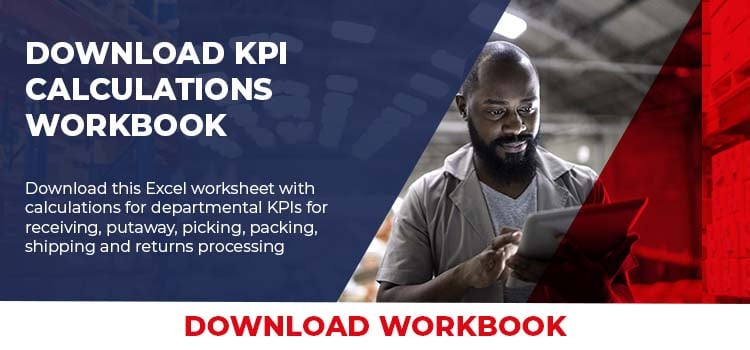Many ecommerce and retail businesses achieve 60% to 70% of their profits in the last quarter of the year. Peak weeks order processing may be 10 to 15 times higher than an average week. For multichannel businesses and wholesalers, their peaks start months earlier to supply other businesses. Take the time after each peak to analyze your fulfillment’s successes and failures and develop a plan to make improvements using a multi-faceted approach.
What were the strengths and weaknesses of your fulfillment in the holiday season? Start with asking your key managers. Front line managers can often identify the symptoms. For instance, a manager may identify absenteeism as a problem, which meant a significant percentage of orders were carried over to the following day. A deeper dive into this insight will help you determine the whys.
Use data to validate everyone’s impressions and figure out how you can improve processes, layout and material handling throughout the fulfillment center. We recommend taking these six steps when analyzing your company’s peak season performance during your warehouse assessment:
1. Assess your supply chain
In order to fully understand your customer service and total fulfillment costs, you need to assess your supply chain and its efficiency. Here are 8 supply chain strategies that will help you, regardless of fulfillment center size or the markets you serve.
We are not saying every company can and should employ these strategies. Which will give you the greatest benefits for the effort and investment?
2. Review key metrics
What internal metrics give you the most accurate picture of your fulfillment performance? Consider these:
- Initial customer order fill rates: This is not the same as a backorder percentage. Initial customer order fill rate is the percent of orders initially filled complete. This metric helps identify inventory availability problems.
- Excess stock: Is low inventory turnover tying up a large number of slots? Is there excess inventory that needs to be liquidated?
- Call center and customer service complaints: From your reporting, what were the major categories of complaint? Use this date to help you paint a picture of key issues to address.
- Error rates: What are your error rates, such as items damaged in transit and mis-picks?
- Return rates: Are these excessive for certain products or vendors? Are you crediting customer accounts within one week of receipt?
- Same-day shipment: To compete with Amazon, many ecommerce businesses are attempting to ship a higher percentage of orders the same day they arrive.
- Supporting other channels: How did you meet SLAs from Amazon, other marketplaces and fulfillment partners? If you’re omnichannel, how well did you support store fulfillment operations? Do these metrics point to potential problems?
3. Analyze shipping and carrier costs
Shipping is the number-one cost of order fulfillment. Were your shipping costs in line with the budget? Did carriers meet your objectives for dropping a trailer daily and meeting cutoffs? Analyze cost of shipping versus shipping and handling income to focus on this major expense.
4. Evaluate hiring and seasonal ramp up
Ask yourself these questions:- How well did your hiring and recruitment process work? What was the cost in terms of management time? What improvements can you make for training employees and lowering ramp-up costs?
- Which seasonal associates do you want to hire full time? Set up a plan to stay in touch with them during the year. Did you offer a bonus for “refer a friend” and staying the entire season?
- If you use temp agencies, how well did they meet your goals?
- How were second shifts managed? Was it difficult or more expensive to staff for peak, and was absenteeism or errors higher than expected?
- What does employee turnover cost you? Is it excessive for your company?
5. Labor performance and process change
Direct and indirect labor is often more than 50% of the fulfillment costs in ecommerce operations, excluding shipping. Typically, the two largest are in picking and packing. If the business is apparel, returns processing are major expenses.
How can processes be improved? Seasonal employees that don’t know your operations or are unfamiliar with fulfillment center work in general are probably best suited for simpler tasks. How can processes be simplified or broken into multiple steps to make functions easier?
Where are your labor dollars spent? What can you do to make processes more efficient in these departments? At the heart of making operational changes should be creating flow diagrams of all processes.
- Slotting: Effective slotting significantly reduces the picker’s travel time, order turnaround and costs considerably. We recommend taking these steps to improve ecommerce warehouse slotting.
- Picking: Many companies need to improve the basics of picking. Others are ready to transition to more advanced methods of picking. This blog gives you 11 ways to improve picking.
- Packing and shipping: All aspects including the process, the ergonomics, packing orders, branding outer cartons, shipping systems and automation should be considered for improvement.
6. Develop improvement plan:
Armed with details and options, develop a plan for improvement. What low hanging fruit is there which should be evaluated and implemented immediately? Chances are you can’t do everything. Set priorities in terms of where you can realize the greatest payback. Some of these findings can be held for re-evaluation and use later.
As you look at your company’s business plans and how well your ecommerce fulfillment performed, develop strategies for improving performance.
Other recommendations may require capital investment and budgeting. Going through a rigorous process of review and analysis after the big rush is over will pay dividends as you get into the new year and look ahead to planning for the next holiday rush.







SHARE